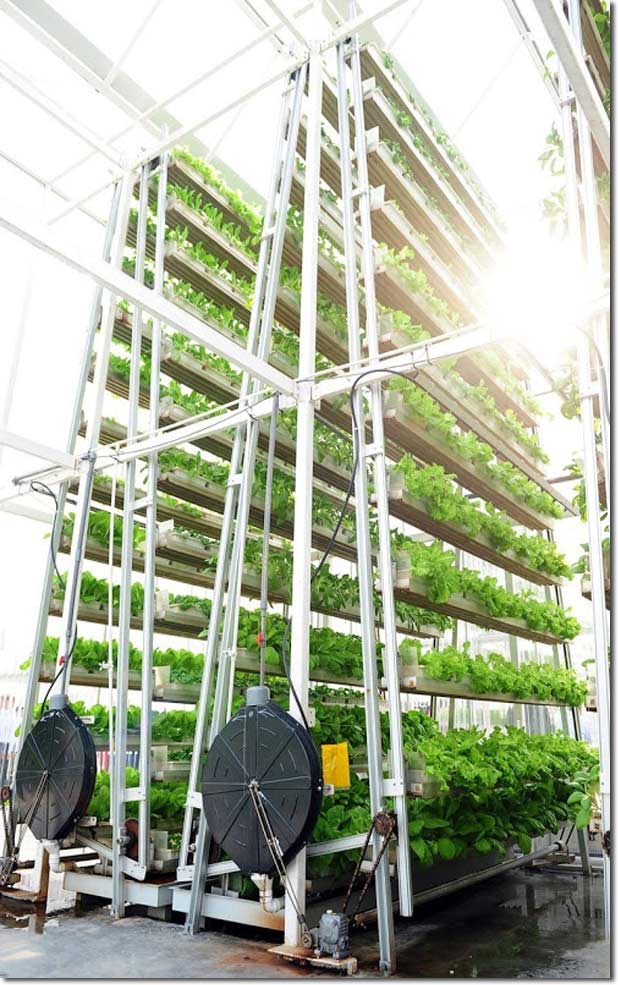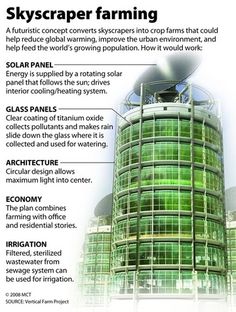“There is nothing stopping us from doing that anymore than there was nothing stopping us from going to the moon” – Anonymous
The advent of agriculture has ushered in an unprecedented increase in the human population and their domesticated animals. Farming catalyzed our transformation from primitive hunter-gatherers to sophisticated urban dwellers in just 10,000 years. Today, over 800 million hectares is committed to soil-based agriculture, or about 38% of the total landmass of the earth. It has re-arranged the landscape in favor of cultivated fields at the expense of natural ecosystems, reducing most natural areas to fragmented, semi-functional units, while completely eliminating many others. A reliable food supply was the result. This singular invention has facilitated our growth as a species to the point now of world domination over the natural world from which we evolved.
Despite the obvious advantage of not having to hunt or scavenge for our next meal, farming has led to new health hazards by creating Eco-tones between the natural world and our cultivated fields. As the result, transmission rates of numerous infectious disease agents have dramatically increased-influenza, rabies, yellow fever, dengue fever, malaria, trypanosomiasis, hookworm, schistosomiasis and today these agents emerge and re-emerge with devastating regularity at the tropical and sub-tropical agricultural interface. Modern agriculture employs a multitude of chemical products, and exposure to toxic levels of some classes of agro-chemicals (pesticides, fungicides) have created other significant health risks that are only now being sorted out by epidemiologists and toxicologists.
As if that were no enough to be concerned about, it is predicted that over the next 50 years, the human population is expected to rise to at least 8.6 billion, requiring an additional 109 hectares to feed them using current technologies, or roughly the size of Brazil. That quantity of additional arable land is simply not available. Without an alternative strategy for dealing with just this one problem, social chaos will surely replace orderly behavior in most over-crowded countries. Novel ways for obtaining an abundant and varied food supply without encroachment into the few remaining functional ecosystems must be seriously entertained.
One solution involves the construction of urban food production centers – vertical farms in which our food would be continuously grown inside of tall buildings within the built environment. If we could engineer this approach to food production, then no crops would ever fail due to severe weather events (floods, droughts, hurricanes, etc.). Produce would be available to city dwellers without the need to transport it thousands of miles from rural farms to city markets. Spoilage would be greatly reduced, since crops would be sold and consumed within moments after harvesting.
What can be proposed here that differs radically from what now exists is to scale up the concept of indoor farming, in which a wide variety of produce is harvested in quantity enough to sustain even the largest of cities without significantly relying on resources beyond the city limits. Cattle, horses, sheep, goats, and other large farm animals seem to fall well outside the paradigm of urban farming. However, raising a wide variety of fowl and pigs are well within the capabilities of indoor farming.
It has been estimated that it will require approximately 300 square feet of intensively farmed indoor space to produce enough food to support a single individual living in an extraterrestrial environment (e.g., on a space station or a colony on the moon or Mars). Working within the framework of these calculations, one vertical farm with an architectural footprint of one square city block and rising up to 30 stories (approximately 3 million square feet) could provide enough nutrition (2,000 calories/day/person) to comfortably accommodate the needs of 10,000 people employing technologies currently available.
Constructing the ideal vertical farm with a far greater yield per square foot will require additional research in many areas- hydro-biology, engineering, industrial microbiology, plant and animal genetics, architecture and design, public health, waste management, physics, and urban planning, to name but a few. The vertical farm is a theoretical construct whose time has arrived, for to fail to produce them in quantity for the world at-large in the near future will surely exacerbate the race for the limited amount of remaining natural resources of an already stressed out planet, creating an intolerable social climate.

(Vertical farms in Singapore)
If vertical farming in urban centers becomes the norm, then one anticipated long-term benefit would be the gradual repair of many of the world’s damaged ecosystems through the systematic abandonment of farmland. In temperate and tropical zones, the re-growth of hardwood forests could play a significant role in carbon sequestration and may help reverse current trends in global climate change. Other benefits of vertical farming include the creation of a sustainable urban environment that encourages good health for all who choose to live there; new employment opportunities, fewer abandoned lots and buildings, cleaner air, safe use of municipal liquid waste, and an abundant supply of safe drinking water.
As of 2004, approximately 800 million hectares of land were in use for food production , and allowing for the harvesting of an ample food supply for the majority of a human population approaching 6.3 billion. These land-use estimates include grazing lands (formerly grasslands) for cattle, and represents nearly 85% of all land that can support at least a minimum level of agricultural activity.
In order to support this large a scale of agricultural activity, millions of hectares of hardwood forest (temperate and tropical), grasslands, wetlands, estuaries, and to a lesser extent coral reefs have been either eliminated or severely damaged with significant loss of biodiversity and wide-spread disruption of ecosystem functions.
Vertical farming practiced on a large scale in urban centers has great potential to:
1. Supply enough food in a sustainable fashion to comfortably feed all of humankind for the foreseeable future.
2. Allow large tracts of land to revert to the natural landscape restoring ecosystem functions and services.
3. Safely and efficiently use the organic portion of human and agricultural waste to produce energy through methane generation, and at the same time significantly reduces populations of vermin (e.g., rats, cockroaches).
4. Re-mediate black water creating a much needed new strategy for the conservation of drinking water
5. Take advantage of abandoned and unused urban spaces.
6. Break the transmission cycle of agents of disease associated with a focally-contaminated environment.
7. Allow year-round food production without loss of yields due to climate change or weather-related events.
8. Eliminate the need for large-scale use of pesticides and herbicides.
9. Provide a major new role for agro-chemical industries (i.e., designing and producing safe, chemically-defined diets for a wide variety of commercially viable plant species.
10. Create an environment that encourages sustainable urban life, promoting a state of good health for all those who choose to live in cities. All of this may sound too good to be true, but careful analysis will show that these are all realistic and achievable goals, given the full development of a few new technologies.

High-rise food-producing building will succeed only if they function by mimicking ecological process, namely by safely and efficiently re-cycling everything organic, and re-cycling water from human waste disposal plants, turning it back into drinking water. Most important, there must be strong, government-supported economic incentives to the private sector, as well as to universities and local government to develop the concept. Ideally, vertical farms must be: a. cheap to build; b. durable and safe to operate; and c. independent of economic subsides and outside support (i.e., show a profit at the end of the day). If these conditions can be realized through an on-going, comprehensive research program, urban agriculture could provide an abundant and varied food supply for the 60% of the people that will be living within cities by the year 2030. This migration is largely caused by the plight of the farmer. “People move to the city for various reasons, but the most significant reason is the economy ,when a city’s economy is prospering it attracts people. The promise of jobs and comfort, glamour and glitter, “pulls” people to cities. There are also “push” factors: droughts or exploitation of farmers can cause extreme rural poverty and that “pushes” people out of the country-side”.
It took humans 10,000 years to learn how to grow most of the crops we now take for granted. Along the way, we despoiled most of the land we worked, often turning verdant, natural Eco-zones into semi-arid deserts. Within that same time frame, we evolved into an urban species, in which 60% of the human population now lives vertically in cities. This means that, for the majority, we humans are protected against the elements, yet we subject our food-bearing plants to the rigors of the great outdoors and can do no more than hope for a good weather year. However, more often than not now, due to a rapidly changing climate regime, that is not what follows. Massive floods, protracted droughts, class 4-5 hurricanes, and severe monsoons take their toll each year, destroying millions of tons of valuable crops. Don’t our harvest-able plants deserve the same level of comfort and protection that we now enjoy? The time is at hand for us to learn how to safely grow our food inside environmentally controlled multi-storey buildings within urban centers. If we do not, then in just another 50 years, the next 3 billion people will surely go hungry, and the world will become a much more unpleasant place in which to live.
“ Sow seeds in the form of Architecture and Harvest Economy in the form of food”